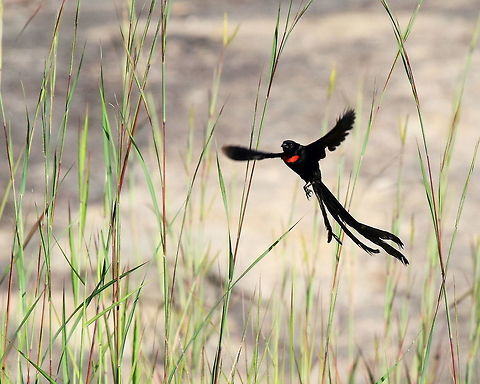
Appearance
Similar to other widowbirds, male red-collared widowbirds have both seasonal and sexual dimorphism. Males are about 25 cm in length while females are only 13 centimeters. A similar trend is seen with weight, where males range from 20 to 26 g and females are only between 16 and 22 grams. During non-breeding seasons, the male plumage is brown, while in breeding season, October to April, they have black plumage with a long tail, approximately 22 cm, and crescent –shaped carotenoid based chest patch. There is significant variation in brightness, hue, and chroma of the carotenoid badges. In contrast, females and subadults, like nonbreeding males, are streaky dull brown with a short tail, approximately 4 cm. Nonbreeding males, however, retain their black tails, while females and subadults' tails are dark-brown.Distribution
Red-collared widowbirds are found throughout Eastern and Southern Africa. While their habitats are varied, they are often found in open grasslands, agricultural areas, clearings in forests, and on slopes with limited tree coverage.⤷ ''Euplectes ardens ardens'' are found in South Mali, North Guinea, inland Sierra Leone. North Liberia, North Ivory Coast, Southwest Niger, Central and Southeast Nigeria, Cameroon, Central African Republic, South Sudan, Democratic Republic of Congo, Central and Northeast Angola, Uganda, West Kenya, Tanzania, Malawi, Northwest and South Mozambique, Swaziland, and East South Africa.
⤷ ''Euplectes ardens laticauda'' are found in Southeast Sudan. Ethiopia, and Eritrea.
⤷ ''Euplectes ardens suahelicus'' are found in the highlands of Kenya and Tanzania.
Status
The red-collared widowbirds are not considered to be globally threatened. They have a very wide range and are found commonly in many regions. They can be found in Kruger National Park, located in South Africa, with a large population of an estimated 2000 individuals. Additionally, the species is found in South and Central Mozambique with approximately 11,000 individuals.Habitat
Red-collared widowbirds are found throughout Eastern and Southern Africa. While their habitats are varied, they are often found in open grasslands, agricultural areas, clearings in forests, and on slopes with limited tree coverage.⤷ ''Euplectes ardens ardens'' are found in South Mali, North Guinea, inland Sierra Leone. North Liberia, North Ivory Coast, Southwest Niger, Central and Southeast Nigeria, Cameroon, Central African Republic, South Sudan, Democratic Republic of Congo, Central and Northeast Angola, Uganda, West Kenya, Tanzania, Malawi, Northwest and South Mozambique, Swaziland, and East South Africa.
⤷ ''Euplectes ardens laticauda'' are found in Southeast Sudan. Ethiopia, and Eritrea.
⤷ ''Euplectes ardens suahelicus'' are found in the highlands of Kenya and Tanzania.
Reproduction
Typical of polygynous species, male red-collared widowbirds do not provide parental care. In fact, the only resources males provide are potential nest sites in their territories. They are different from other Euplectes species in that the males use only a simple nest ring in courtship and the females build and position the actual nests. The nests are usually oval in shape and the females line the nests with grass. Females continue to add to the nest during the incubation. Old nests are often occupied by zebra waxbills. There are usually between 2 and 4 eggs in a clutch, each egg being greyish or blue-green, with brown speckles. The incubation period, done only by the female, is between 12 and 15 days. Females also do all of the feeding, primarily via regurgitation, during the nestling period for the offspring, which is between 14 and 17 days. The nests are commonly parasitized by Diederik cuckoos.Because they are offering no other gifts, it is very important for the males to establish an exclusive territory at the beginning of the breeding season to ensure successful mating. Males aggressively defend their territories from intruders. There is no difference in costs or benefits between females who choose unmated males, monogamy, and females who settle with mated males, polygyny. Females may gain indirect benefits of picking higher quality males by producing higher-quality offspring, without suffering costs of shared territories.
Food
Red-collared widowbirds feed on seeds of Sorghum and other grass seeds. They also feed on nectar, small berries, and insects, specifically ants, caterpillars, and termites. They often form large roosts, with between 50 and 100 individuals, which feed together on the ground. These roosts included breeding males. They are often formed with association with other species, like red-billed quelea, fan-tailed widowbird, southern red bishop, white-winged widowbird, and yellow bishop.References:
Some text fragments are auto parsed from Wikipedia.